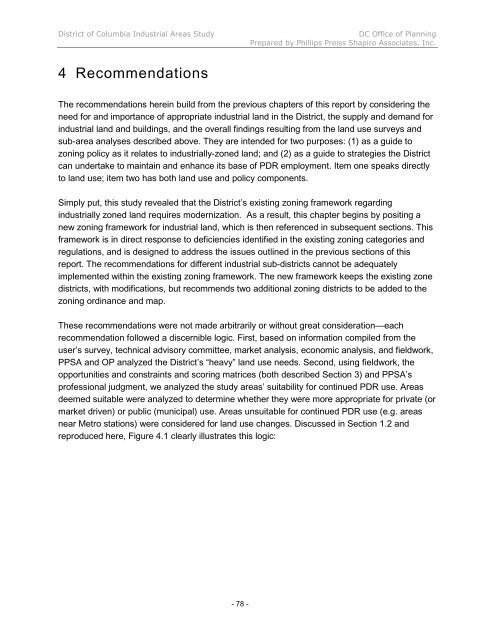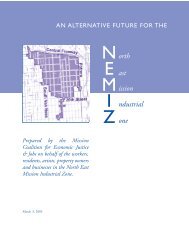INDUSTRIAL LAND IN A POST-INDUSTRIAL CITY District of ...
INDUSTRIAL LAND IN A POST-INDUSTRIAL CITY District of ...
INDUSTRIAL LAND IN A POST-INDUSTRIAL CITY District of ...
You also want an ePaper? Increase the reach of your titles
YUMPU automatically turns print PDFs into web optimized ePapers that Google loves.
<strong>District</strong> <strong>of</strong> Columbia Industrial Areas Study DC Office <strong>of</strong> Planning<br />
Prepared by Phillips Preiss Shapiro Associates, Inc.<br />
4 Recommendations<br />
The recommendations herein build from the previous chapters <strong>of</strong> this report by considering the<br />
need for and importance <strong>of</strong> appropriate industrial land in the <strong>District</strong>, the supply and demand for<br />
industrial land and buildings, and the overall findings resulting from the land use surveys and<br />
sub-area analyses described above. They are intended for two purposes: (1) as a guide to<br />
zoning policy as it relates to industrially-zoned land; and (2) as a guide to strategies the <strong>District</strong><br />
can undertake to maintain and enhance its base <strong>of</strong> PDR employment. Item one speaks directly<br />
to land use; item two has both land use and policy components.<br />
Simply put, this study revealed that the <strong>District</strong>’s existing zoning framework regarding<br />
industrially zoned land requires modernization. As a result, this chapter begins by positing a<br />
new zoning framework for industrial land, which is then referenced in subsequent sections. This<br />
framework is in direct response to deficiencies identified in the existing zoning categories and<br />
regulations, and is designed to address the issues outlined in the previous sections <strong>of</strong> this<br />
report. The recommendations for different industrial sub-districts cannot be adequately<br />
implemented within the existing zoning framework. The new framework keeps the existing zone<br />
districts, with modifications, but recommends two additional zoning districts to be added to the<br />
zoning ordinance and map.<br />
These recommendations were not made arbitrarily or without great consideration—each<br />
recommendation followed a discernible logic. First, based on information compiled from the<br />
user’s survey, technical advisory committee, market analysis, economic analysis, and fieldwork,<br />
PPSA and OP analyzed the <strong>District</strong>’s “heavy” land use needs. Second, using fieldwork, the<br />
opportunities and constraints and scoring matrices (both described Section 3) and PPSA’s<br />
pr<strong>of</strong>essional judgment, we analyzed the study areas’ suitability for continued PDR use. Areas<br />
deemed suitable were analyzed to determine whether they were more appropriate for private (or<br />
market driven) or public (municipal) use. Areas unsuitable for continued PDR use (e.g. areas<br />
near Metro stations) were considered for land use changes. Discussed in Section 1.2 and<br />
reproduced here, Figure 4.1 clearly illustrates this logic:<br />
- 78 -












